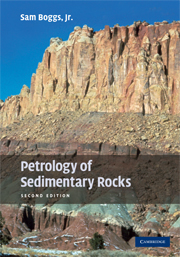Book contents
- Frontmatter
- Contents
- Preface
- Part I Principles
- Part II Siliciclastic sedimentary rocks
- Chapter 2 Sedimentary textures
- Chapter 3 Sedimentary structures
- Chapter 4 Sandstones
- Chapter 5 Conglomerates
- Chapter 6 Mudstones and shales
- Chapter 7 Provenance of siliciclastic sedimentary rocks
- Chapter 8 Diagenesis of sandstones and shales
- Part III Carbonate sedimentary rocks
- Part IV Other chemical/biochemical sedimentary rocks and carbonaceous sedimentary rocks
- References
- Index
- References
Chapter 8 - Diagenesis of sandstones and shales
from Part II - Siliciclastic sedimentary rocks
Published online by Cambridge University Press: 05 June 2012
- Frontmatter
- Contents
- Preface
- Part I Principles
- Part II Siliciclastic sedimentary rocks
- Chapter 2 Sedimentary textures
- Chapter 3 Sedimentary structures
- Chapter 4 Sandstones
- Chapter 5 Conglomerates
- Chapter 6 Mudstones and shales
- Chapter 7 Provenance of siliciclastic sedimentary rocks
- Chapter 8 Diagenesis of sandstones and shales
- Part III Carbonate sedimentary rocks
- Part IV Other chemical/biochemical sedimentary rocks and carbonaceous sedimentary rocks
- References
- Index
- References
Summary
Introduction
Petrologic study of siliciclastic sedimentary rocks commonly focuses on interpretation of sediment provenance and depositional paleoenvironments. It may aim also at evaluating the economic significance of these sediments as source rocks or reservoir rocks for petroleum or as hosts for ore deposits. Discussion in previous chapters suggests that genetic interpretations can be compromised by postdepositional changes in composition or texture brought about by diagenetic processes. Provenance interpretation, in particular, can be severely affected by diagenetic processes that selectively remove feldspars, heavy minerals, or rock fragments by intrastratal solution. Diagenesis may also play an extremely important role in postdepositional modification of porosity, causing either decrease in porosity as a result of compaction and cementation or increase in porosity owing to solution processes. Thus, the economic importance of a particular sandstone body as a reservoir rock for petroleum, for example, may very well depend as much upon the diagenetic history of the sandstone as upon its original depositional characteristics. Therefore, to avoid erroneous interpretations of petrogenesis or costly errors in economic evaluations, it is necessary to understand as much as possible about the diagenetic processes that can affect siliciclastic sedimentary rocks. We are concerned not only with the nature of diagenetic processes but also with the types of changes that are produced in the rocks as a result of these processes. That is, we strive to recognize the diagenetic characteristics of siliciclastic rocks and to differentiate these diagenetic features from original depositional characteristics.
- Type
- Chapter
- Information
- Petrology of Sedimentary Rocks , pp. 268 - 310Publisher: Cambridge University PressPrint publication year: 2009



